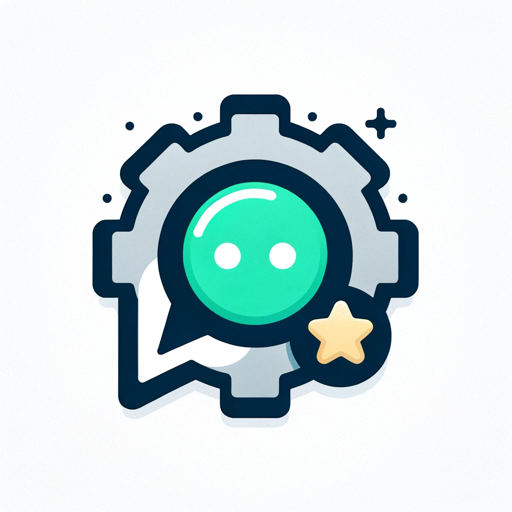LLM Prompt Guide-AI-powered prompt optimization tool.
Optimize your prompts with AI insights.
How to use the LLM Prompt Guide
What are best practices in prompt engineering?
How do different prompts affect LLM outcomes?
Describe an effective LLM prompt using an analogy.
Related Tools
Load More
Agent Prompt Generator for LLM's
4.4 ★ It generates the best possible LLM-agents for your system prompts. You can also specify the model size, like 3B, 33B, 70B, etc.

Master Prompt
Expert en ingénierie de prompts pour ChatGPT, spécialisé dans l'optimisation et l'évaluation des requêtes.

Pro Prompter
Automatically re-write your prompts based on OpenAI's Prompt Engineering Guide

LLM Course
An interactive version of the LLM course tailored to your level (https://github.com/mlabonne/llm-course)

Prompt Engineer
Crafts effective prompts using OpenAI best practices

Prompt Peerless - Complete Prompt Optimization
Premier AI Prompt Engineer for Advanced LLM Optimization, Enhancing AI-to-AI Interaction and Comprehension. Create -> Optimize -> Revise iteratively
20.0 / 5 (200 votes)
Introduction to LLM Prompt Guide
LLM Prompt Guide is designed to provide practical, structured guidance for crafting and optimizing prompts for Large Language Models (LLMs). Its core objective is to help users improve the way they interact with AI models by providing tailored, actionable techniques for creating effective prompts. The guide emphasizes clarity, efficiency, and iterative refinement to achieve desired outcomes from LLMs. It covers various methods such as few-shot learning, step-by-step task breakdowns, and contextual instruction to ensure accurate and useful outputs from models like GPT-3, GPT-4, and others. For example, a basic task such as summarizing an article might involve a prompt like 'Summarize the following article in three bullet points,' whereas a more complex task could require structured role assignment or context, like 'You are a financial advisor; summarize this investment report for a client.' In both scenarios, LLM Prompt Guide offers strategies to fine-tune the output.

Main Functions of LLM Prompt Guide
Contextual Prompt Structuring
Example
Use detailed context to influence the model's behavior by assigning roles or tasks. For example, when using a system message such as 'You are a tax advisor helping a client with deductions,' the model will tailor its answers accordingly.
Scenario
In real-world use, this function can help professionals like tax consultants, customer support agents, or HR managers by framing their queries in a specific professional context to get precise, task-oriented responses from the model.
Iterative Prompt Refinement
Example
Test and refine prompts through a step-by-step process. For instance, a marketing manager may first ask 'Generate blog post ideas about our new product' and then refine it with a follow-up prompt, 'Focus on sustainability benefits in the ideas.'
Scenario
Marketers, content creators, and managers can use this iterative approach to continuously improve the quality and relevance of their content output, making sure the generated ideas align closely with business goals.
Few-Shot and Chain-of-Thought Prompting
Example
Provide the model with one or more examples to guide its response. For example, 'Here's a summary of a marketing report; now write a similar one for a sales report.'
Scenario
Analysts, writers, and project managers can use this function to model specific examples of reports or other documents they need generated, ensuring the output maintains consistency with their expectations.
Ideal Users of LLM Prompt Guide
Professional Users
This group includes project managers, content creators, and analysts who frequently use AI tools to draft content, write reports, or automate routine tasks. The LLM Prompt Guide helps them by offering structured ways to refine prompts, ensuring that outputs are aligned with their professional requirements, saving time while enhancing productivity.
AI Enthusiasts and Developers
AI developers and enthusiasts who are interested in learning how to better control model outputs will benefit from the detailed strategies in LLM Prompt Guide. It provides advanced techniques, such as controlling output randomness and crafting prompts that mitigate hallucinations, making it easier for developers to fine-tune AI behavior in specialized applications.

How to Use LLM Prompt Guide
Visit aichatonline.org for a free trial without login, also no need for ChatGPT Plus.
This step allows immediate access to the LLM Prompt Guide without requiring any subscription or account creation.
Familiarize yourself with basic prompt structures.
Understand core concepts such as instructions, primary content, examples, and few-shot prompting, which are crucial for effective LLM interactions.
Identify your use case.
Determine the specific application for the guide—academic writing, programming assistance, summarization, etc. This helps you craft more targeted and effective prompts.
Iterate and refine your prompts.
Use trial and error by tweaking prompts, as model responses improve with better-defined instructions and examples. This is especially critical for complex tasks.
Leverage advanced techniques.
Explore few-shot learning, chain-of-thought, or output-specific cues to maximize response quality for intricate applications like multi-step reasoning or grounded outputs.
Try other advanced and practical GPTs
Character Art Creator
AI-driven character creation tool

ArticleGPT
AI-Powered Article Creation

Caricature Creator
AI-Powered Fun for Face Exaggeration!

Property Law Tutor
AI-powered Property Law tutoring tool
Cooking4two
Your AI-powered culinary companion.

PIKA 1.0 Prompt Specialist
AI-powered video generation at your command

Human Rights GPT
AI-powered research for human rights insights.

NESTED
AI-powered custom solutions for businesses.

Investor Deck Assistant
AI-powered investor decks in minutes

code
AI-powered code for faster development.

Prompt Engineering Helper
Enhance AI responses with custom prompts

GPT-Rage
AI-Powered Assistant for GTA and FiveM.

- Academic Writing
- Creative Writing
- Data Analysis
- Code Generation
- Text Summarization
Common Questions About LLM Prompt Guide
What is the LLM Prompt Guide used for?
The LLM Prompt Guide assists users in designing effective prompts to interact with AI models like GPT-4, optimizing outputs for tasks such as summarization, translation, or creative writing.
Do I need prior experience to use it?
No, the guide caters to both beginners and advanced users. It provides essential instructions and strategies for anyone to start building effective prompts, regardless of technical expertise.
Can it improve model response accuracy?
Yes, by applying structured prompts with specific instructions, content, and examples, users can significantly improve the accuracy and relevance of AI-generated outputs.
How do I test if my prompt is effective?
Run multiple iterations of your prompt with different variations, observe the responses, and refine instructions or examples. Use trial and error to fine-tune for the desired outcome.
Does it support specific domains or applications?
The guide is versatile and supports various domains such as programming, content generation, academic work, or even conversational AI applications. The structure can be tailored to different needs.